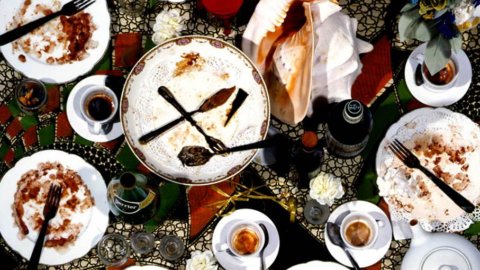The exhibition presents a selection of works created by great international artists from the XNUMXs to today. Drawings, objects, installations, photographs and videos dedicated to the theme of art and cooking. On stage are the works of Sonja Allhäuser, Joseph Beuys, Tobias Hantmann, Felix Gonzàlez-Torres, Schirin Kretschmann, Maik und Dirk Löbbert, Aldo Mondino, Heike Mutter + Ulrich Genth, Martin Pfeifle, Claus Richter, Rudolf Schwarzkogler, Daniel Spoerri, Wolfang Stehle, Thomas Sterna, Stefan Tschurtschenthaler
The visual arts have always carefully considered the theme of food. Just think of Leonardo da Vinci's Last Supper, the still lifes painted by Dutch masters of the seventeenth century or the work Breakfast on the grass by Édouard Manet. Since the XNUMXs and the birth of “Eat Art” food has gone from being a reason for two-dimensional artistic representation to being used as a material for creating works of art.
The exhibition “ARTIST'S RECIPES. Between art and cuisine” presents a series of positions that approach objects and actions related to cooking and food from various points of view. The spectrum of thematic exploration is varied, it embraces existential and sensory aspects characteristic of the world of cuisine, food and drink, but also the aesthetics of materials and the symbolism of certain foods. The exhibition also includes works that express a form of social criticism aimed at questioning the consumer society and the absurdity of some of our daily consumption behaviours. Other works deal with the common elements between artistic achievement and culinary preparation.
The exhibition begins with a series of works from the 1973s and XNUMXs, such as a XNUMX tableau piège by the Romanian-Swiss artist Daniel Spoerri. It is a sort of pop-up image from which the remains of a coffee/cigarette break emerge. Spoerri's famous trap paintings are made of real crockery and leftover food that the artist has secured to the same table on which they were left after their use/consumption. The only thing that changes is the position of the elements with respect to the observer, from horizontal the table is placed vertically and the aspect it assumes is that of a painting.
Joseph Beuys assigns an important symbolic meaning to foods such as honey, fish, animal fat. The "Honey pump" edition of 1985 is a sort of summa of Beuysian art. It includes drawings, photographs and a tape recording of a 6-hour action in which the artist explains the concept behind the work he created in 1977 for dOCUMENTA VI “Honey pump at work”.
“Placebo (Landscape for Roni)” (1973) is a work by the Cuban artist Felix Gonzalez-Torres, composed of 500 Kg of chocolates in gold paper made in 1993. Visitors to the exhibition are explicitly invited to pick up the chocolates and eat them, an aspect that intentionally wants to lead to the very dissolution of work. The consumption and assimilation of the work thus triggers a very special closeness between the viewer and the work of art.
“Maccaron” (1998) instead reflects on the good manners of being at the table and on the culture of food. The German author Wolfgang Stehle has created an object made with bowls, plates and pots aimed at preserving everyone's dining placemat from any food stains. A work that transforms an everyday act into a completely absurd behavior, reflecting with irony on the actual usefulness of modern kitchen equipment.
The video “The Perfect Kitchen Show” (2013), by Thomas Sterna shows the South Tyrolean artist in a fully equipped kitchen preparing a dish according to the instructions given by a TV chef. The kitchen, a symbol of bourgeois order, slowly begins to rotate on its axis, while utensils and food fall from the cupboards, generating total chaos, from which the artist, however, does not let himself be distracted, stoically continuing to cook.
Stefan Tschurtschenthaler has created a project specially designed for the exhibition. Over the course of several seasons, he went to the garden of the Merano herbalist Priska Weger and photographed some wild herbs there. This type of herb, which assumes the role of "silent helpers" in the culinary preparation, becomes an unexpected subject in the photos of the artist from Merano. He wanted to show them from a new perspective, thus thematizing our relationship with nature.





